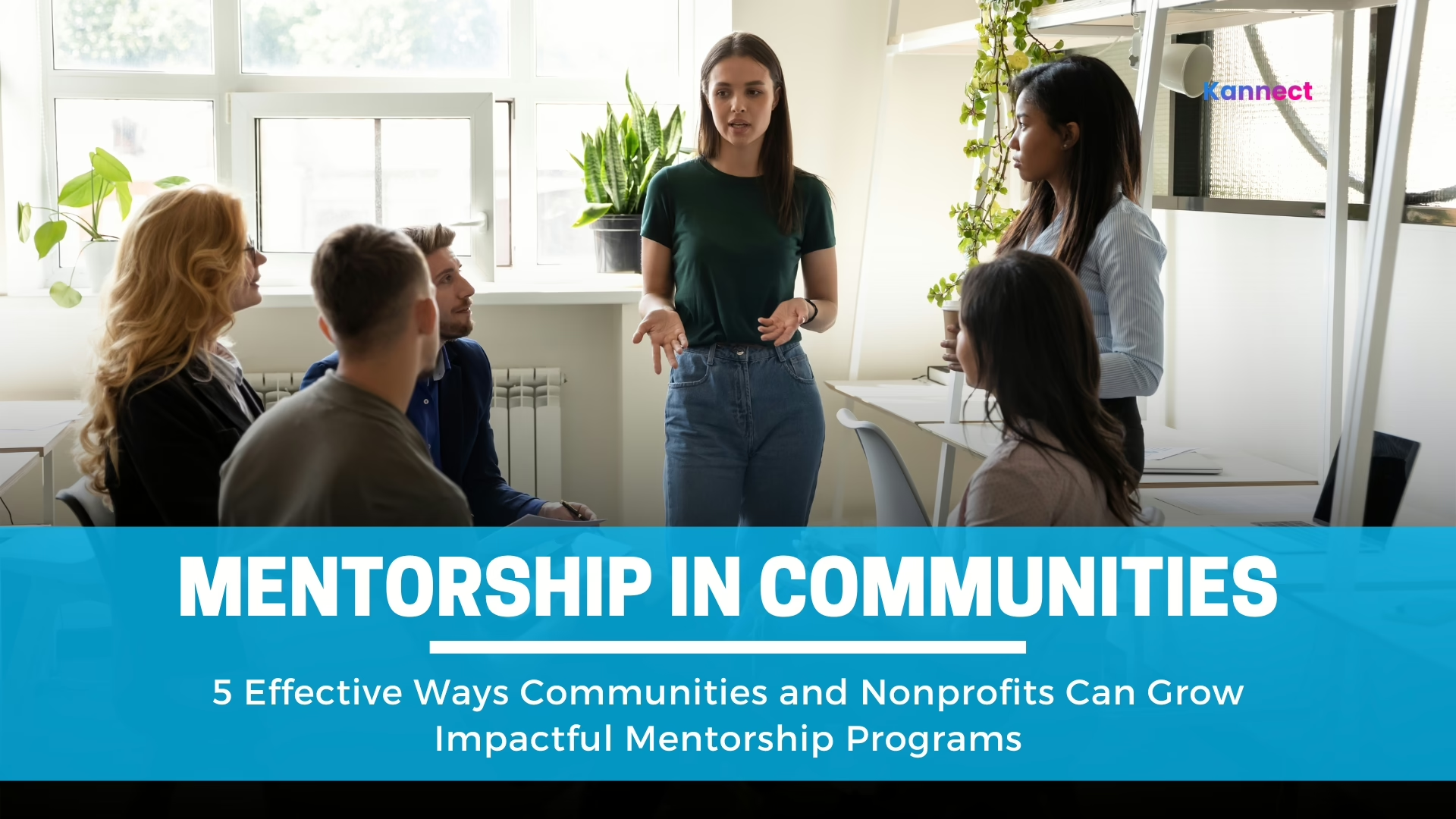
What is Mentorship: 5 Effective Ways Communities Can Grow Mentorship Programs
Table of Contents
Smart Summary: Here’s what this blog on Mentorship will explore
▶ What is Mentorship? (Mentorship Meaning and Definition)
A developmental relationship where an experienced individual guides personal and professional growth through knowledge sharing and support.
▶ Why Mentorship is Important
It builds future leaders, enhances essential skills, and deepens engagement within communities and nonprofits, driving sustainable impact.
▶ The Five Pillars of Mentoring
Trust, goal-setting, knowledge exchange, ongoing feedback, and fostering independence create a solid foundation for successful growth.
▶ Mentorship vs. Coaching
Mentorship focuses on long-term, holistic development, while coaching targets shorter-term, specific skill improvement.
▶ Mentorship and Leadership
Guidance nurtures strategic thinking, decision-making, and interpersonal skills, preparing emerging leaders for real-world challenges.
▶ What is Peer Mentorship?
A reciprocal support system where peers with similar experience levels collaborate to learn, hold each other accountable, and strengthen community bonds.
▶ 5 Trending Ways to Build Mentorship in Communities and Nonprofits
Structured programs, corporate partnerships, peer mentoring groups, virtual platforms like Kannect, and micro-mentoring sessions innovate how mentoring is delivered.
▶ How Kannect Supports Mentorship in Communities and Nonprofits
Kannect simplifies managing mentoring with tools for matching, scheduling, collaboration spaces, progress tracking, and resource hubs to empower effective relationships.
▶ Ready to Grow Your Mentorship Program?
Join Kannect today to access tools and resources designed to strengthen your community through impactful mentoring relationships.
▶ FAQs
Answering key questions about mentoring definitions, importance, differences from coaching, steps, peer mentoring, program building, and how Kannect aids the process.
Let’s Dive In!
What is a Mentorship? (Mentorship Definition and Meaning)
Mentorship is a supportive and developmental relationship in which a more experienced individual, known as the mentor, guides and advises a less experienced person, the mentee. This relationship fosters knowledge sharing, skill development, and personal growth tailored to the mentee’s individual goals and needs. Unlike simple advice-giving, mentorship is a collaborative and ongoing process that involves listening, providing encouragement, offering constructive feedback, and empowering the mentee to find their own path forward.
Mentorship often extends beyond professional guidance to include psychosocial support, helping mentees build confidence, resilience, and a broader perspective. It creates a climate of trust and mutual respect, allowing mentees to explore challenges and opportunities safely. Mentorship relationships can vary in length, from short-term engagements focused on specific goals to long-term partnerships, often evolving as both mentor and mentee grow.
In many communities and nonprofits, mentorship also plays a critical role in nurturing leaders, transferring institutional knowledge, and strengthening organizational culture. By connecting experience with fresh perspectives, mentorship promotes sustained development for individuals and the collective.
Why Mentorship is Important (Benefits of mentorship)
Mentorship plays a vital role in building community capacity by connecting experienced mentors with motivated mentees, creating a continuous cycle of learning and growth. It strengthens leadership pipelines by preparing emerging leaders with the skills, confidence, and network they need to succeed. For example, mentorship programs have helped young community leaders gain strategic thinking abilities and deepen their understanding of nonprofit operations, enabling them to take on greater responsibilities.
Mentorship also significantly enhances member engagement by fostering meaningful relationships and a sense of belonging. When members feel supported through personalized guidance, they are more motivated to contribute actively. For instance, a nonprofit partnering with corporate mentors under a CSR initiative provides mentees access to industry expertise, which not only boosts individual development but also broadens the organization’s impact.
Moreover, mentorship accelerates learning by offering real-time feedback and tailored advice, enabling mentees to overcome challenges faster than they would alone. It fosters inclusivity by opening doors to diverse perspectives and experiences, ensuring that mentorship programs are accessible to all members regardless of background.
Ultimately, mentorship cultivates future leaders who are equipped to sustain and grow community initiatives, making it an indispensable investment for the long-term health and success of nonprofits and community groups.
The Five Pillars of Mentoring
Here are the five key steps to a successful guiding relationship, with practical examples for each:
- Establishing Trust:
Building a safe and open connection is the foundation. This could mean a mentor openly shares not only their achievements but also setbacks, showing vulnerability and authenticity. For example, a leader who talks honestly about a failed project makes it easier for their mentee to seek advice and share their own challenges without fear or embarrassment. - Setting Goals:
Both parties align on clear expectations from the outset, what they want to achieve and how they’ll measure progress. For instance, a youth leader and mentor may set a goal to develop project management skills, outlining steps and timelines together. This clarity reduces misunderstandings and keeps the relationship focused. - Sharing Knowledge:
The exchange goes far beyond textbooks. Mentors share real-life stories, lessons learned, and practical advice, while mentees contribute fresh perspectives. Think of a nonprofit founder describing lessons from their earliest fundraising fails, helping a new member learn faster through lived experience. - Providing Feedback:
Honest, regular, and constructive feedback helps the mentee grow. This might be a mentor observing a new community manager running their first online event, offering supportive notes on what went well and where to tweak for next time. Feedback should be specific, kind, and aimed at empowering. - Encouraging Growth:
True support means cheering on independence, celebrating successes and learning from setbacks. For example, when a mentee creates their first campaign solo, the mentor offers encouragement and recognizes progress, helping build confidence and readiness for bigger roles.
With these steps, guiding relationships become not just a transfer of knowledge, but a catalyst for lasting impact and growth for both participants.
Mentorship vs. Coaching
Though often used interchangeably, these two forms of development have clear differences:
- Duration and Focus:
Mentoring is typically a long-term relationship focused on holistic personal and professional growth. For example, a nonprofit leader may guide a volunteer over several years, helping them navigate career decisions and leadership challenges. In contrast, coaching is usually short-term and goal-oriented, targeting specific skills like improving public speaking or mastering grant writing. - Structure:
Coaching sessions often follow a structured agenda, with measurable outcomes and frequent progress reviews. Conversely, mentoring tends to be more informal and flexible, adapting to the mentee’s evolving needs and interests. - Roles and Dynamics:
A mentor shares personal experiences, industry insights, and advice, often taking a directive role in guiding the mentee. In coaching, the coach encourages self-discovery by asking open-ended questions, letting the coachee lead the learning process. - Objective:
Coaching strives to boost performance by focusing on particular competencies or overcoming immediate obstacles. Mentoring cultivates broader development including career progression and emotional intelligence. - Example:
An emerging community leader might receive coaching to learn fundraising tactics for an upcoming event. Simultaneously, that leader could have a mentor offering wisdom on balancing leadership responsibilities and personal well-being over time.
Understanding these distinctions helps organizations offer the right support, blending both to optimize member and leader growth.
Mentorship and Leadership
Guidance from experienced individuals is crucial for developing effective leaders within communities and nonprofits. This process nurtures critical leadership qualities such as strategic thinking, sound decision-making, and strong interpersonal skills, helping emerging leaders navigate complex challenges with confidence.

Key ways leadership grows through this dynamic include:
- Targeted Advice and Real-World Insights:
Experienced mentors offer practical guidance grounded in their own journeys, helping leaders understand not just what to do but why. For example, Satya Nadella credits Bill Gates’ mentorship with shaping his empathetic and collaborative leadership style at Microsoft, which drove transformative change. - Sharing Lessons Learned:
Mentors pass down knowledge from both successes and failures, providing mentees with a balanced perspective. Richard Branson’s openness about entrepreneurial risks is a classic illustration, teaching aspiring leaders to embrace innovation fearlessly. - Goal-Oriented Development:
Structured relationships with clear leadership competency goals help mentees grow in measurable ways. At IBM, a senior executive worked with her mentee to improve project management skills and expand professional networking, revisiting goals regularly for steady progress. - Hands-On Experiences:
Effective leadership training prioritizes immersive activities. Mentees gain confidence by managing actual community projects or role-playing complex scenarios, which develops problem-solving and decision-making capacities in real time. - Regular Feedback and Dialogue:
Constructive feedback loops between mentor and mentee enable continuous improvement. Companies like Google encourage bi-weekly meetings focused on discussing challenges and refining leadership capabilities, strengthening accountability and growth.
This supportive and personalized approach ensures emerging leaders gain not only knowledge but also the practical skills and emotional intelligence to inspire, guide, and sustain their communities. Leadership development through such close, experienced guidance creates a resilient pipeline equipped to face future demands.
What is Peer Mentorship?
Peer mentorship is a collaborative relationship where individuals at similar levels of experience support each other’s growth and development. Unlike traditional one-way mentoring, peer mentoring emphasizes mutual learning, accountability, and shared challenges, fostering an environment of openness and equal partnership.
Key aspects include:
- Mutual Learning and Support:
Peers exchange knowledge and experiences relevant to their current challenges. For example, two community organizers might regularly discuss strategies for volunteer engagement, offering fresh perspectives based on recent successes or lessons learned. - Shared Accountability:
Both participants hold each other responsible for goals and commitments, which increases motivation to progress. This balance encourages honest feedback and constructive critique without hierarchical pressures. - Strengthened Community Bonds:
By working together in a less formal, more approachable setting, peers build deeper trust and connection. A peer mentorship group in a nonprofit may naturally evolve into a supportive network where members celebrate wins and navigate setbacks as a team. - Continuous and Flexible:
Peer mentorship tends to be an ongoing process, adapting organically to participants’ needs. Unlike traditional mentorship, which might conclude after a certain phase, peer support can last indefinitely as both members grow. - Diverse Perspectives & Emotional Support:
Peers often bring varied skills and viewpoints, enhancing creativity and problem-solving. They also empathize with each others’ struggles uniquely well, creating a safe space for emotional well-being.
For example, a peer mentoring collective in a social impact organization might pair program managers who learn from each other’s challenges managing projects and teams, enhancing leadership skills collaboratively.
This equal and dynamic exchange makes peer mentorship a powerful complement to traditional mentoring, especially in vibrant nonprofit and community settings.
5 Trending Ways to Build Mentorship in Communities and Nonprofits
- Structured Mentorship Programs:
Designing clear frameworks with defined roles, timelines, and goals helps ensure commitment and measurable progress. For example, a community center might create a year-long program pairing new volunteers with experienced leaders, including monthly check-ins and skill workshops to track growth. - Corporate Partnerships:
Leveraging corporate social responsibility (CSR), nonprofits invite company leaders to mentor community members, sharing expertise while expanding networks. Avon’s collaboration with various nonprofits includes senior executives mentoring women entrepreneurs, providing both strategic guidance and expanded funding opportunities. - Peer Mentorship Collectives:
Facilitating small groups where members at similar experience levels mentor each other fosters inclusivity and shared ownership. A youth program might create peer circles where members alternate roles as mentors and mentees, enhancing confidence and collective problem-solving. - Virtual Platforms:
Utilizing technology to connect mentors and mentees breaks geographic barriers and enables flexible engagement. Platforms like Kannect help nonprofits track relationships, schedule sessions, and measure impact, all remotely. - Micro-Mentoring Sessions:
Offering short, focused mentorship bursts allows participants to gain targeted advice quickly without lengthy commitments. For instance, a nonprofit might host “mentor speed dating” events, where volunteers get several 15-minute consultations from experts on fundraising, marketing, or event planning.
These evolving approaches not only improve access but also make mentorship more adaptable and engaging, meeting the diverse needs of community members and nonprofit leaders alike.
How Kannect Supports Mentorship in Communities and Nonprofits
Kannect’s all-in-one platform simplifies the complex task of managing mentorship programs by integrating essential features that support every stage of the relationship, making it easier for organizations to foster meaningful connections and leadership development.
- Efficient Matching and Onboarding:
Kannect uses smart algorithms and customizable profiles to pair mentors and mentees based on skills, interests, and goals. This personalized matching ensures participants connect with the right partners for growth. For instance, a community organization used Kannect to successfully onboard new volunteer mentors by sending personalized welcome messages and guiding them through resources directly on the platform. - Seamless Scheduling for Sessions:
Whether sessions are virtual or in-person, scheduling is streamlined through integrated calendars and automated reminders. This reduces the risk of missed meetings and helps maintain momentum. For example, a nonprofit running a leadership development program found that automated scheduling helped increase attendance by 30% over previous manual methods. - Private Group Spaces:
Dedicated groups enable peer mentorship and collective learning, where small clusters can share insights and support each other. These spaces foster collaboration beyond one-on-one connections, strengthening community bonds. A youth empowerment network successfully created peer circles within Kannect to facilitate ongoing dialogue and collective problem-solving. - Progress Tracking and Feedback Mechanisms:
Tools for monitoring goal attainment, collecting feedback, and assessing engagement provide actionable insights for continuous improvement. Program coordinators can identify when mentees need additional support or when mentors require guidance, allowing proactive interventions. - Resource Sharing Hubs:
Central libraries for mentoring guides, training materials, and best practices are easily accessible by all participants, encouraging continuous learning. This feature was key for an educational nonprofit that regularly updates training modules within Kannect, ensuring mentors have up-to-date tools and knowledge.
Through these integrated tools, Kannect empowers organizations to build structured, scalable, and effective programs that support leadership growth and forge lasting connections across communities.
Ready to Grow Your Mentorship Program?
Join the Kannect community and harness our powerful tools to build mentorship programs that inspire growth, connection, and impact.
💡 Create your free Kannect account today or schedule a demo and start empowering leaders and members through effective mentorship.
🔔 Stay connected and inspired by following Kannect on our social platforms (links below) for expert advice, success stories, and practical resources that strengthen your mission.
✔️ Subscribe to The Community Engagement Playbook for weekly strategies and insights to nurture authentic engagement and sustainable community growth.
Take the leap: empower your members, unlock potential, and amplify the impact of your nonprofit and community with Kannect. Your journey to enhanced mentorship and stronger communities begins here.
Try Kannect today

FAQ: Quick Answers to All Your Questions
What is the definition of mentorship? (Define mentorship)
Mentorship is a supportive relationship where an experienced individual offers guidance, knowledge, and encouragement to help another person grow personally and professionally. This ongoing partnership focuses on learning, development, and mutual trust, tailored to the mentee’s aspirations.
Why is mentorship important in nonprofits and examples of mentorship?
It plays a critical role in strengthening leadership pipelines, accelerating skill transfer among volunteers and staff, and boosting engagement. For example, new nonprofit leaders gain confidence and practical know-how faster when supported by seasoned mentors, which translates into more effective programs and stronger community impact.
How does the mentorship differ from coaching?
While coaching is often short-term and concentrated on specific skill enhancement or tasks, mentorship is broader and longer-term, focusing on overall growth and career development. Coaching may be directive and structured, whereas mentorship tends to be more flexible and relationship-driven, involving storytelling, advice, and personal support.
What are the five key steps in effective mentoring?
- Building trust to create a safe learning environment.
- Setting clear goals that align expectations.
- Sharing knowledge through guidance and lived experiences.
- Providing ongoing, constructive feedback.
- Encouraging independence to empower confidence and decision-making.
What is peer mentorship?
Peer mentorship is a collaborative relationship where individuals of similar experience levels support each other’s learning and accountability. It fosters mutual growth, strengthens community bonds, and provides emotional and practical support in a non-hierarchical setting.
How can nonprofits establish effective mentoring programs?
Successful programs start with structured planning, clear roles, and defined timelines. Partnerships with corporations and use of technology platforms help scale mentoring efforts. Ongoing monitoring and resource sharing ensure continuous improvement and relevance.
How does Kannect facilitate mentoring activities?
Kannect offers tools for efficient mentor-mentee matching, streamlining communication, session scheduling, progress tracking, and resource sharing. This integrated approach reduces administrative complexity while enhancing participant engagement and program impact.



